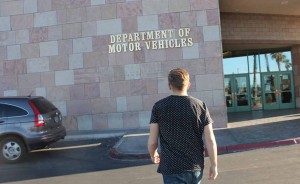By Karen Pegueros

The time has come. You’ve been waiting for this basically your whole life. Your parents are going crazy. Their biggest fear is finally a reality; you’re ready to drive.
The first step is to pick up or print the DMV Driver Handbook and start studying. There are apps and websites you can use that provide mock exams, but these should not be an alternative to reading the book.
When going to get your permit, make sure to bring the following: the handbook to study while you’re waiting, your updated passport and social security card, house bills to prove your residence, a signed attendance form from your school’s attendance office, and, of course, your parent or guardian.
To prepare for the written test, read the DMV Driver Handbook from cover to cover because everything in that is fair game. Even if you won’t be cruising around town on a Harley Davidson, you still have to read that section because a large portion of the test concentrates on motorcyclists.
To apply for a full license you must be at least 16 years old, and in the six months prior to applying, hold a valid instruction permit, have no “at-fault” crashes, and obtain no moving violation or alcohol/drug convictions of any kind.
You must bring your permit and completed driving log with all 50 hours completed, 40 in the day and 10 at night, a valid signed attendance form, and your driver’s education certificate of completion or an official transcript. However if you are over 18, a permit, driving hours, and an attendance form are not required.
The exam consists of 50 multiple choice questions and a vision test. In order to pass, you must score 80% or higher, only missing up to 10 in the allotted amount of time. You are allowed to skip 10 questions and revisit them at the end. There is a testing fee of $26 for the permit. An $11 retest fee will apply to retake the exam after the initial attempt.
Make sure you arrive at the DMV at least 15 minutes prior to your appointment. The DMV has to test hundreds of people a day, and if you’re late, they won’t wait up. Rather than parking regularly, have your parent or guardian reverse park for you because the parking lot is very tight. Then you won’t have to worry about pulling out and hitting other cars.
The test starts with a simple drive around the block testing the driving skills you have learned throughout your six months of practice. When you are finished with the drive, you will be asked to parallel park. You can practice your parallel parking at the DMV every Sunday; the cones are left in the exact same position in which they will appear during the test. Then you will drive to the main parking lot to park. All of this will count towards your exam.
During the exam, don’t play any music, and always keep your hands on the wheel. Don’t switch the radio stations or drink soda, even at a stoplight. Be sure to joke around with or compliment your instructor before the exam begins to lighten the mood.
If you don’t pass, your driving instructor will let you know when you can go back to retake the test. Again, in order to pass, you must earn an 80% or higher. The test is based on a set point system. The licensing fee is $23.25.
The DMV is open 8 a.m. to 5 p.m. on weekdays and 8 a.m. to 4 p.m. on Saturdays. It is closed on Sundays.
After receiving your license, drivers under 18 years old may not drive between 10 p.m. and 5 a.m. on weekdays and past midnight on Fridays and Saturdays, unless they are traveling from a school activity, scheduled event, or work. They may not drive any passengers under 18, excluding immediate family members, for six months.
Learning to drive can be a scary experience. In the blink of an eye, everything can go wrong. Be sure to always follow the law, and most importantly, to drive safe.











